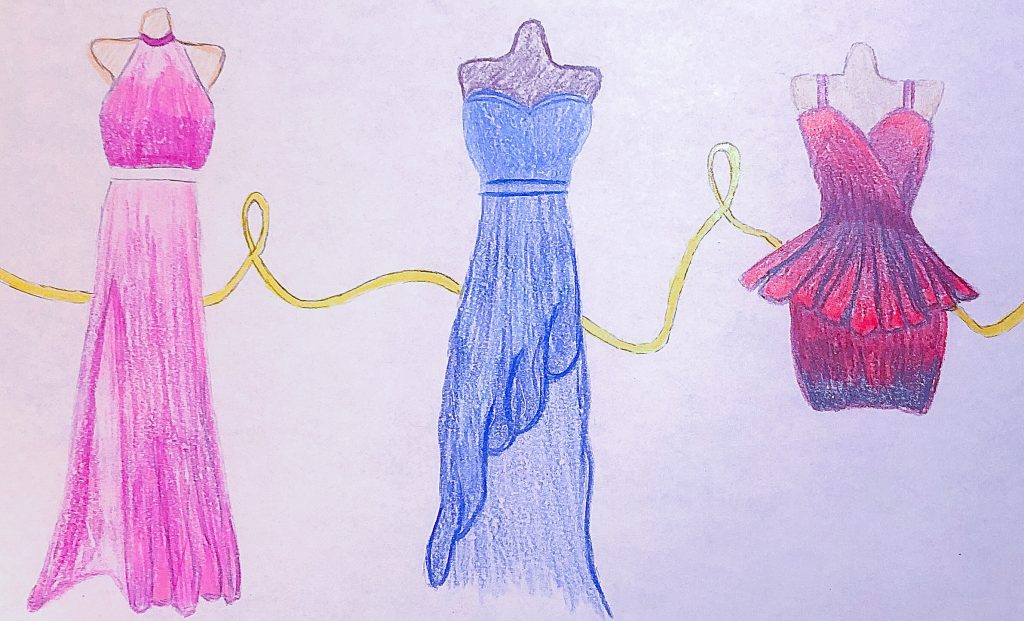In the mid- to late 1800s the concept of prom blossomed. Short for promenade, or “the formal, introductory parading of guests at a party,” prom was supposed to promote social etiquette and manners in each year’s graduating class. Just as the purpose of prom has evolved, styles of female dress especially have had some major changes that’ll make you wonder, why was that ever a trend?
Let’s start with the 1930s. Prom dresses at this time were quite modest and sleek. They typically gathered at the natural waist and draped over the shoulders, obeying the time’s social standards. They had subtle, if any patterns, and many dresses from this time appear as though they’d be more suited on a Victorian bedspread.
During the 1940s, the body silhouette was accentuated as dresses came in tighter at the waist and flowed to the ground. Some daring women would expose their shoulders, making that style commonplace.
Toward the end of the 1940s and into the 1950s, fuller, tulle skirts were all the rage. These dresses were cinched at the top and fluffy fabric popped out at the waist. Sashes were also very on-trend. Additionally, dresses became a bit shorter and colors were often vibrant.
Entering the 1960s, the poofy skirt trend faded, waistlines got higher and dresses became slimmer. There was a sort of rebirth of older, sleek dresses with a bit of a twist. They were almost always tied with some kind of bow above the waist attached to a flowy pencil shaped silhouette below. Dresses were colorful, but muted pastel tones, and if they had patterns they were typically a sort of lace.
There was a dramatic trend shift as we venture into the 1970s. Women were very experimental with their dresses and they did not confine themselves to any specific trend. You’ll see metallic dresses, sparkly dresses, and dresses covered in different arrangements of ruffles. The movie Carrie was also a huge influence on prom dresses in the late 1970s and girls would look there for some inspiration. Looking at these dresses now can make them seem quite tacky.
Dresses in the 80s were crazy! Think of styles from the 70s and amp every aspect up a notch: Brighter colors, more exotic patterns, and more ruffles! It seemed there was no amount of ruffles that was considered “too much”. The tulle skirt made a bold return from the 1950s (fashion seems to circulate every 30 years), and even more of it was used. Andie’s dress from Pretty In Pink was one of the most beloved dresses of the times. This DIY would not be acceptable nowadays, but girls were mesmerized by it in the 80s.
The 1990s could be split into remaining trends from the 80s and styles shared with the 2000s. A few details unique to this time though were shoulder pads and the off-the-shoulder style.
The early 2000s dresses will seem more normal to us now as they were slim, sleek and typically had spaghetti straps. Colors and sparkles were present, but within reason. Some old trends came back later on like tulle but this time it was often tiered in 2008 specifically. The long princess dress came into fashion with Hillary Duff’s A Cinderella Story. Evidently, movies have had a significant effect on what dresses become popular.
Lastly, the 2010s. Similar to the early 2000s, dresses were fitted and colorful with sequins and beads. We later see a return of beautiful vintage lace patterns as well with more muted tones. Most recently, dresses have become more form fitting and silky, typically with low necks.
Now we can only imagine what trends are in store for the 2020s! Which trends will last and which old one’s will come back into style?
Tess Cundiff
social media & digital editor
Graphic: Zoe Kovac

